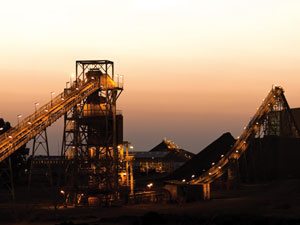
[miningmx.com] – THE mining sector is suffering a hangover of skull-cracking proportions. Ill discipline, unrealistic expectations, and complacency all have their place in an examination of commodity markets in the last ten to 12 years.
The “super cycle’, as it was known, was a spectacular place to be, however. Driven by unstinting growth in China, the 30 to 40 years from 2002 were supposed to result in huge demand for steel and the stuff that goes into making steel such as manganese and iron ore.
Since 2003, the gold price gained 372%; iron ore became 302% more expensive, the price of copper increased 384% while thermal coal gained 273% in price. At first, share prices responded providing investors with good capital gains.
Even now, the HSBC Global Mining Index is 235% higher than in 2003 whereas the FTSE 100 and Dow Jones is 78% and 82% higher respectively. But share prices aren’t the whole picture. Since 2010, margins have been shrinking drastically.
According to a study of the world’s top 40 mining companies by PricewaterhouseCoopers, the gross margin of the world’s top gold companies fell 29% compared to the share price compared to gross margins of 49% in 2010.
The acid test, however, has been return on capital employed (ROCE), a ratio that digs deeper than just earnings, and provides an insight into how effectively management has used capital.
At the beginning of the super cycle, mining companies used their money relatively well with ROCE rising to 23% in 2006 from 5% in 2002.
Thereafter, however, the trouble begins. As mining companies became more enthusiastic about the never ending gift that was the super cycle, now aided with talk of India joining China as a world powerhouse, so the spending on capital projects increased, and with abandon.
ROCE fell from 23% to 9% by 2009 amid the economic and financial crisis; it bounced in 2010 back to 18% but slipped again to 8% – its lowest collective level in 10 years – in 2012.
In the last two years, the breakdown of capital discipline in mining management started to reflect in the shares. The HSBC Global Mining Index declined 30% whereas the Dow Jones Industrial Average was 16% higher from 2012.
As a result, investors are asking mining management to deal more carefully with their dollars.
First, though, there’s been a widescale clean out of management who have been replaced with new leaders whom investors have ordered to focus on cash returns, dividends, or yield as it’s termed.
“Investors are saying this is their capital,’ says Carel Smit, head of markets, energy and natural resources at KPMG in Johannesburg. “They are saying: ‘we will invest in your iron ore mine, but don’t use the profits to buy a coal mine. Give it back to us in dividends'”.
The catalyst for the failure of the world’s mining sector has been a decline in the rate of China’s economic growth to “only’ 7% or 8%. This has led to an adjustment in prices while in a separate development, the 10-year bull run in the gold price has been stopped dead in its tracks by potential changes to monetary policy in the US.
South African complexity
In South Africa, the picture is – somewhat depressingly – more complex. The promulgation of empowerment regulations in 2004 just as the super cycle was kicking off muddied the investment waters here for potential new investors who had more options anyway by dint of the expansions in production elsewhere in the world.
Never mind new investors in South Africa. Existing investors here became anxious about issues such as security of tenure and government policy as a whole. It’s an uncertainty that has tended to increase rather than abate, unfortunately for us.
“I don’t see any reason why any normal fund manager would consider investing in the gold and platinum mines here because there are just so many variables,’ said Peter Major, a mining consultant to Cadiz Corporate solutions.
“Managers spend too much time on politicised issues and not enough time with their reports on operational issues,’ he says, adding that growing problems containing demands from labour is a particular thorn in the side of investors.
“You have to be very selective,’ said David Pleming, an investment manager at the privately-owned Tantalum Capital. “To be honest, there’s probably more value looking globally,’ he said.
He sets down four key criteria when assessing investment in the current mining market. “The first question to ask is: what is the ability of companies to achieve production growth, especially if they can’t grow revenue through increased metal prices?
“Secondly, who can reduce costs through cyclical and structural adjustments. And thirdly, which are the companies that have gearing to a stronger dollar or domestic currency weakness,’ he says. Finally, you need a company with a strong balance sheet.
Set against this dire macro-economic backdrop, and the specific problems posed by mining in the South African context, the question remains as to where potential investors can find value.
“There are more reasons to sell than there are for buying,’ said Daniel Sacks, an analyst for Investec Asset Management in Cape Town.
First, though, a word of hope.
The mining market will recover. It’s noteworthy that former mining captains such as Aaron Regent (Barrick Gold), Mick Davis (Xstrata), and Leigh Clifford (Rio Tinto) have re-booted their careers. What’s most interesting, however, is the fact that private equity capital is backing them.
In search of value after several years of drifting, private equity companies such as KKR & Company and TPG Investments have seen value in the mining sector; that the gasket-blowing enthusiasm has perhaps been overdone.
A study by Preqin, a consultancy that provides information on private equity, real estate and hedge funds, showed that eight natural resources funds focused solely on mining raised an aggregate of $8.5bn in 2012, more than the years 2006 to 2012 combined.
“Private equity has never been keen on mining resources in the past owing to the cyclicality of the market,’ head of Macquarie Research’s mining research in South Africa, Kieran Daly, told Miningmx in an article published in June.
“But there have been a number of former mining CEOs popping up running them such that Mick is likely to have decent competition for these assets,’ he said.
Platinum proclivities
The hunger with which investors are buying up Absa Capital’s platinum debenture – an exchange traded product (ETN) – tells us everything we need to know about expectations for the metal. Or does it? “That metal has to be SA stamped so it shows that there’s still a lot of liquidity in the market,’ said Tantalum’s Pleming.
According to a study by Thomson Reuters GFMS last year, there was an estimated 500,000 ounces of above ground “investment’ stocks of platinum that would act as a surplus and cap the price.
Still, the fundamental picture for platinum remains good, according to Wilhelm Hertzog, a portoflio manager for Re:CM. “We have already seen producers cutting back on production but we see more of the recovery in the platinum price coming with increased demand,’ Hertzog said.
Automotive production in Europe has reached its lowest levels on record, according to Hertzog and while he’s not calling “the bottom of the market’, the view is that we’re pretty close to it. As a result, he believes the best options, outside of the platinum ETN, are the large platinum producers that have the ability to cut production and withstand the pressure.
“The big three producers have control of the [platinum] market and are in a better position than the smaller producers,’ said Hertzog. He prefers Impala Platinum.
Gilding the lily
No-one understands how the gold market really works. Look no further than the response of the metal’s price to the partial closure of the US government. Given the threat of US debt default to the global economy, you’d expect gold price weakness. Instead, the gold price weakened itself. Perplexing.
The consensus, however, is that South African gold stocks are not the place to be: restive labour, mature orebodies and therefore high cost. “Any mine that is close to adulthood and you’re screwed,’ said Major. “The shafts are deep, the labour force is poor, there are bad unions,’ he adds.
Perhaps the only option for investors would be Pan African Resources, a company that operates the Evander and Barberton gold mines, as well as some platinum retreatment operations. The company is well run with a strong low cost, entrepeneurial culture. Major also likes Sibanye Gold which he says is run by South Africa’s best gold manager in Neal Froneman [its CEO].
“I think the [gold] bull market is over,’ says Sacks. “So it’s probably not a bad idea to frontload production,’ he says of Sibanye’s strategy which is to optimise the mature mines of two mines near Carletonville – Libanon and Driefontein – and another in the Free State, the Beatrix mine.
Froneman has been making much of extending the lives of the west Rand mines, but the attraction of Sibanye is that it’s going to extract the last ounce of value from the operations for the most cash, and return it to shareholders.
Sibanye Gold was also priced at a relatively low level when it listed on the JSE, analysts say. From a valuation point of view, it also makes sense to be in the stock. As supported by its recent interim dividend in which it paid out 25% of annualised earnings, equal to 37c/share, the company is also positioning itself as a high yield share. “They need to keep that going in order to remain attractive,’ says Major.
Glasenberg largesse
In the current market in which the mining industry finds itself, David Pleming of Tantalum Capital believes companies with tier one assets are perhaps the best bet for investors with an interest in mining.
“Companies with tier one assets, without balance sheet issues, and good management. BHP Billiton fits in that category, but the large diversifieds are probably the best option. GlencoreXstrata is another,’ he says.
In fact, GlencoreXstrata is due to be listed on the JSE before the year end and will certainly provide local investors with more choice.
In these financially difficult times, it’s also worth noting the company’s management, led by South African-born CEO, Ivan Glasenberg, hold about 25% of the company. This compares to the 1% held by management in Anglo American or 0.03% held by managers in BHP Billiton, Rio Tinto and Freeport. It shows GlencoreXstrata management have more to lose and aligns them closer with investors who bet on the company’s shares.
Petrol head
The most bearish comments on the commodity market come from Paul Theron, owner of independent stockbrokerage, Vestact. Interestingly, Theron has a sanguine view of the market: “I’m not too negative on demand; I don’t, for instance, think China will go off the boil. I just don’t think the market wants to pay double-digits for future earnings’.
He also thinks the cache for mining stocks is relatively small whereas the pharmaceutical and technology markets are larger and have wider appeal.
One “tactical’ trade, however, is Sasol. “I like the idea of them pressing on with the plant in Louisiana’. This is the $5bn to $7bn Lake Charles plant due for commissioning in 2017 and which will convert ethane natural gas to ethylene. Ethylene is used to produce raw materials for paint and detergents.
The area in which Sasol is building has a lot of infrastructure already and is therefore low risk from that perspective. “I like that story,’ said Theron. “ExxonMobil could buy up Sasol in a blink. Positioning in Sasol is key; it’ll be worth keeping an eye on,’ he said.
Sasol also has enormous leverage. “For every $1 increase in the price of a barrel of oil, Sasol’s operating profit will increase by $67m,’ said Vestact in a recent report.
“When it comes to the exchange rate, for every 10c that the rand weakens, their operating profit increases by R 939m under the assumption of $108 a barrel, and at the exchange rate of R9.05.
“So if exchange rates stay where they are and oil stays above $108/b, Sasol will make an extra R84.5 billion operating profit (200% increase) just from the exchange rate!,” it said.
Selling coal to Eskom
The outlook for thermal coal prices looks uninspiring unless, of course, the coal is being supplied to Eskom. Based on its application for tariff increases last year, Eskom said it would pay an average of R349/t between 2012 and 2018, equal to a 10.4% annual increase per year over six years.
In contrast, international coal prices have been under pressure, down from $110/t less than two years ago to $79/t, the current price for thermal coal ex-Richards Bay to which exporters have to add the $50/t railage cost (if it’s to Richards Bay) and a further $30/t in handling costs at Richards Bay Coal Terminal (RBCT).
In the current market, it looks reasonable to lock-in the kinds of prices Eskom is prepared to offer while still having some production from export. Perhaps the only major risk is whether Transnet can make good on plans to improve rail links from the emergent Waterberg coalfields in South Africa’s Limpopo province. It is starting to improve on its deliveries to RBCT, for instance.
These are long shots and of a long-term nature, but companies operating in this space are Resource Generation (Australian-listed); Firestone Energy and Waterberg Coal Company on the JSE, and Continental Coal (JSE).










